Crawling Back: Amazing Spider-Man #17 Review (The Osborn Prelude, Part 2)
The Goblin's second appearance is marked by some plot convenience but is largely driven by the mounting misfortunes of its titular teenage hero
—by Nathan on September 19, 2023—
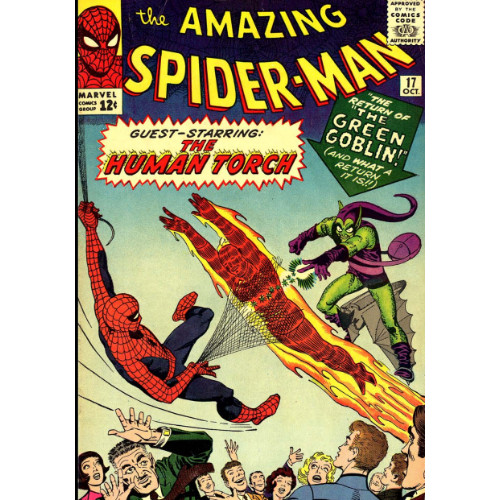
A mere three issues after his green, garish grin first popped up in Amazing Spider-Man #14, the villain who’d become (arguably) Spider-Man’s greatest foe made his triumphant return. And I do mean triumphant.
When we examined the initial appearance of the gruesome gargoyle known as the Green Goblin, the supervillain had clandestinely corralled our favorite Web-Head, pitting Spidey against the Goblin, the Enforcers, and even (though unwittingly) the Hulk. The Goblin’s arrival marked a turn in the Stan Lee/Steve Ditko method of crafting colorful crooks and cronies: here was a man on a mission, decidedly against Spidey, and with a secret identity to boot. Readers now know the face behind the mask, but in 1964, his true name was a mystery, his face hidden in shadow or by the Halloween fright mask he wore.
As I creep closer to the fateful confrontation between Peter Parker and Harry Osborn that, temporarily, marked the end of the Goblin legacy, I’m examining other appearances by the Green Goblin, be he Norman Osborn, Harry, or maybe even another face who took the mantle for a spin. We’ve only just begun untangling the Goblin’s first forays into criminal caper-dom, so join me as we dive into some good old-fashioned vengeance on that pesky Wall-Crawler.
“The Return of the Green Goblin”
Writer: Stan Lee
Penciler: Steve Ditko
Inker: Steve Ditko
Colorist: Stan Goldberg
Letterer: Sam Rosen
Issue: Amazing Spider-Man #17
Issue Publication Date: October 1964
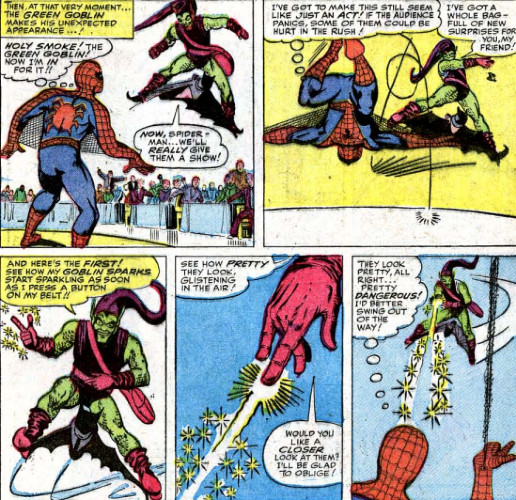
I spoke, previously, on how Amazing Spider-Man was fairly malleable during its first several issues–some basics were established pretty quickly (Peter was a very smart high school student, worked for the Daily Bugle to support himself and his aunt, and generally fought crime during his free time as Spider-Man) but other details were left more ambiguous or subject to change. Take Liz Allen, for example. Initially somewhat rude to Peter, she turned a new leaf and, by time this issue rolled around, even seemed infatuated with the young man, much to the consternation of then-beau Flash Thompson.
But one established element lingered painfully in the background: The Parker Luck. The oh-so-dreaded Parker Luck. And this issue’s chock full of it.
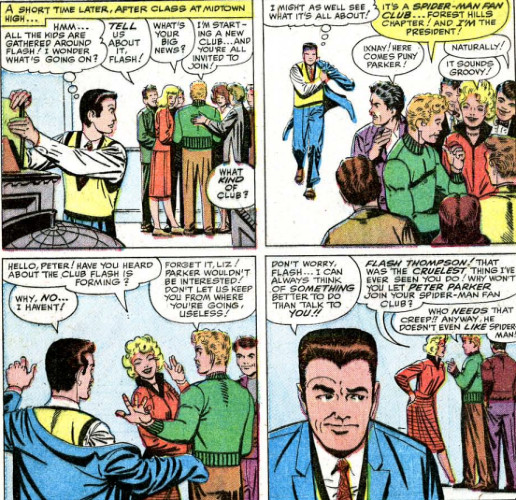
Lee and Ditko, masterfully, weave a crippling amount of painful irony for our beloved Web-Head in this issue. Peter feels incapable of catching a break from the jump. Whether it’s Flash Thompson announcing the formation of a Spidey fan club he doesn’t want Peter belonging to, Liz Allen trying to draw Peter into the club’s launch in front of Betty Brant, or Spidey jumping into action to truss up some crooks who turn out to be actors for a movie…the dude finds himself at odds every which way he turns.
For Peter, the "Spider-Man" identity is (supposed to be) a surefire way for him to move away, even temporarily, from his Parker problems. It’s a comfortable fortress, a literal mask to keep away worries about money, girls, or even the health concerns of his ever-ailing aunt. Lee and Ditko really turn the screws when they begin giving him problems to deal with as Spidey, such as nearly trouncing actors, his rash decision leading him to ignore a suspicious-looking fella later revealed to be a crook. It’s this ever-amassing rain of blows on Spidey’s back as he’s trying to navigate life. The hits just keep on coming.
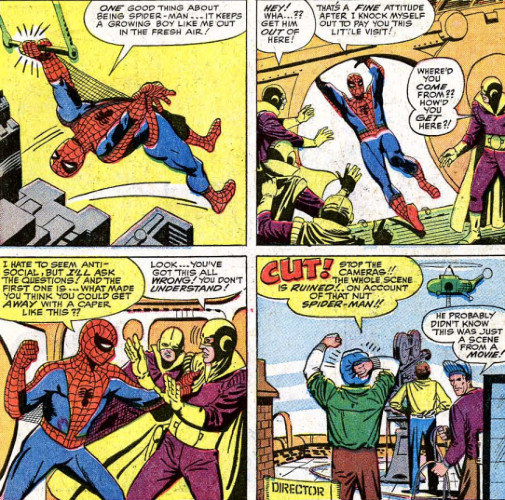
This series of misfortune could end up becoming really overblown by Lee and Ditko, so what keeps this issue from grating is how interwoven the different difficulties are. Flash forming a Spider-Man club leads Liz to frustrate Peter and Betty’s time together, and Spidey’s acceptance of the invitation to the club’s first meeting leads to his second confrontation with the Goblin. Even during the club sequences, as Spidey bounces from trouncing the Goblin back to Peter Parker, allowing frenemy Johnny "Human Torch" Storm a few licks at the verdant villain, Peter can’t catch a break. Recurring characters and emotions fly hither and yon across each page, and I’m genuinely impressed by how well Lee and Ditko tether everything together. Were these treated as separate or disconnected instances, the weight of the growing agonies would feel lackluster and largely coincidental. I'd probably roll my eyes as yet another misfortune struck at Peter, pulling him further into a web of trouble. Yet each event is precipitated by a prior event or compounded by additional troubles.
Coincidence does strike now and again, with the Green Goblin’s second appearance coinciding with Peter’s recent curiosities about his freakish foe. I wonder what became of him, Peter ponders in the middle of class, like the Goblin’s some old pen pal who forgot to write. Why hasn’t he been heard from since? This scene is juxtaposed with a reintroduction to the villain, where Ditko has some fun laying out the Goblin’s updated weaponry and gear, particularly as they really double down on the Halloween imagery teased by the Goblin and his flying broomstick a few issues prior. Aunt May’s health issues pop up inexplicably at the worst possible time late in the issue, driving Spidey away from a fight and causing onlookers to label him a coward. Happenstance is the nature of moments such as these, thrown in to provide additional tension and pilot the story in the direction Lee and Ditko wish to go. This "Spider-Man coward?" piece forms a miniature arc across the next few issues, so even if the impetus is coincidental, we understand Lee and Ditko’s reasoning.
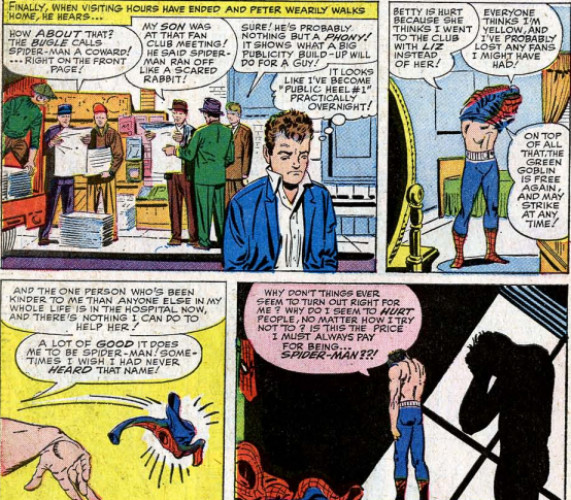
We’re not given much additional information regarding the Green Goblin’s identity in this issue, other than he’s a regular Joe who browses the paper like other regular Joes and learns about the Spidey fan club through the printed medium (as opposed to, I assume, social media if this issue were updated for modern audiences). The mystery is placed on the backburner in favor of the Parker Luck problems, which is fine for now. Honestly, though the mystery lingers in the background of other issues, not much is gleaned about the Goblin until the revelation of his identity, compounding the shock of the twist. As I wondered in my last post, I don’t know at what stage Lee and Ditko were at in developing the Goblin’s identity when this issue was created. For now, it doesn’t matter so much. This issue is all about revenge.
Ditko concocts a stellar sequence where the Goblin attacks Spidey at the club, much to the initial amusement of attendees, who only later realize how serious this fight is. He wonderfully juxtaposes the Goblin’s speed on his glider with Spidey’s acrobatics, creating an aerial battle akin to Spidey’s confrontations with the Vulture. Action moves fluidly from panel to panel as each opponent responds to the other–a bolt of patent-pending "goblin sparks" are dodged effortlessly by Spidey; Spidey lunges at the Goblin, only for his foe to evade him vertically; Spidey rolls out of the way of one of the Goblin’s classic pumpkin bombs. Between Spidey and the Torch’s efforts, the fight lasts a total of nine pages, a decent chunk of comic, nicely interspersed with jeers and cheers from the peanut gallery watching.
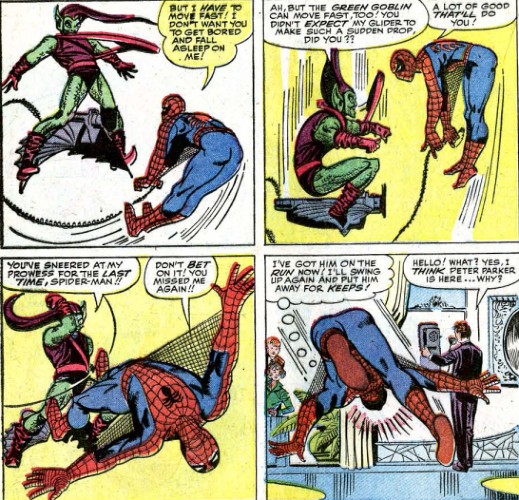
Lee’s subplotting is as conundrum-causing as ever, especially as he plays up the Peter/Liz/Betty triangle…and that’s before he tosses in the continuing mystery of this "Mary Jane" person! I’ve complained, previously, about Lee’s goofy romance subplots, but I always felt the Spidey love interest stuff wasn’t as bizarre. Rereading some of these issues has made me backpedal a tad. The triangle itself is fine, creating decent tension. But Lee doesn’t allow Betty, specifically, the intelligence she deserves, giving her over, as he has before, to bursts of emotions and leaps in logic so vast you’d think she was aiming for the moon. Peter himself refers to her as his girlfriend when Aunt May tries setting him up a blind date with Mary Jane (really, May?), and though this is a great moment grounded in logic, why he doesn’t just make that clear with Betty is anyone’s guess. Are they not on the same page? Is Liz, though sweet on Peter, intentionally driving a wedge between Peter and Betty? I’d make a joke about Flash and Betty going out together to make Liz and Peter jealous, but that hits a tad too close to home. It’s all far sillier than I remembered, but it’s been a while since I read these issues, and I feel far more capable of picking up subtext than when I was younger.
This issue is packed with twists and turns, from Flash creating a fan club for his beloved superhero but denying entry to the man behind the mask, to the Green Goblin making his dramatic second appearance in an effort to humiliate our hero in front of his doting fans. A few moments of plot convenience linger around the fringes, straining the bounds of credibility, and a couple of panels reinforce Lee’s trademark yet downright goofy subplots. But between Lee and Ditko, the latter of whom is responsible for the excellent action driving the issue’s second half, we get an excellent reappearance of the elfin evildoer destined to haunt Spidey’s nightmares for decades to come.